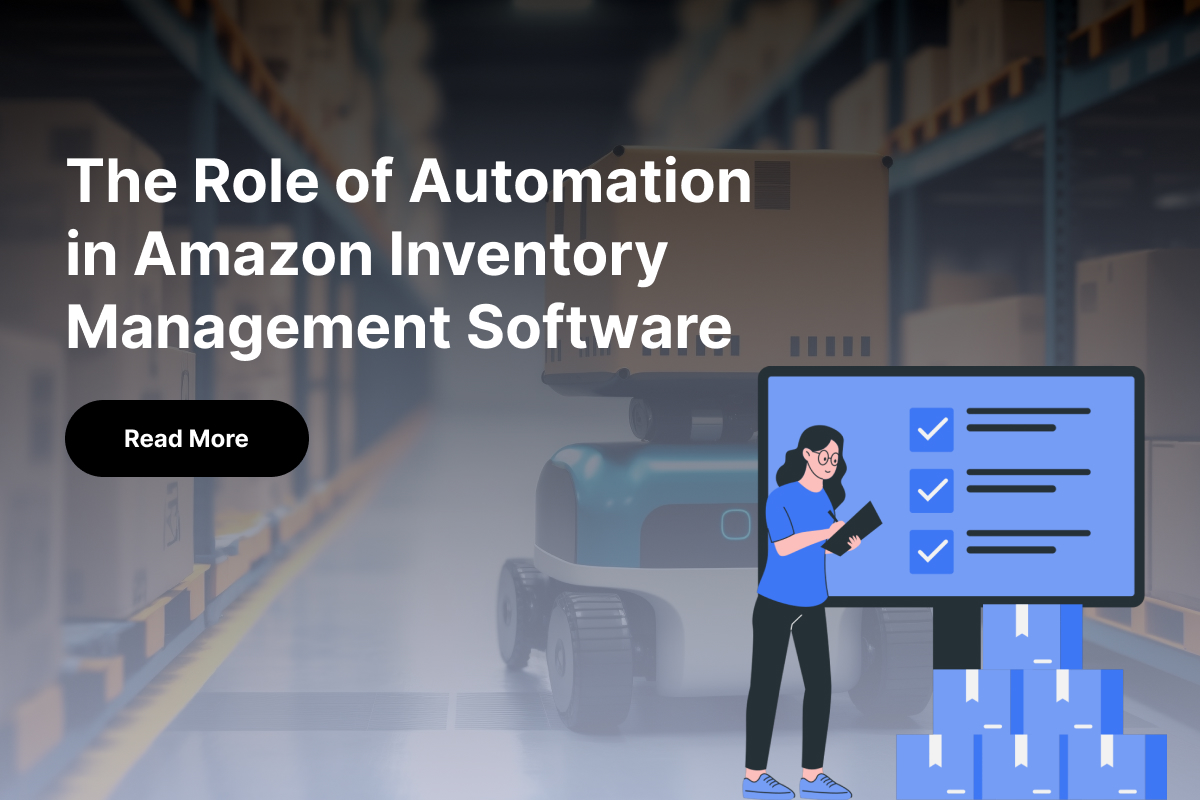Blog Software Development
The Role of Automation in Amazon Inventory Management Software

Streamlining Inventory Tracking with Automated Amazon Software
Managing inventory on Amazon can be complex, but automated software solutions are revolutionizing the process. These tools streamline inventory tracking by providing real-time updates, optimizing stock levels, and automating routine tasks. With automated software, businesses can prevent stockouts, reduce human error, and ensure that their products are always available for customers. This leads to improved efficiency, better customer satisfaction, and ultimately, higher sales. Embrace automation to stay ahead in the competitive Amazon marketplace.
How Automated Amazon Inventory Management Saves You Time and Money
Automated Amazon inventory management is a game-changer for businesses. By leveraging advanced software, you can automate routine tasks like tracking stock levels, reordering products, and updating listings. This not only reduces the risk of human error but also frees up valuable time, allowing you to focus on growing your business. Automation helps in avoiding costly stockouts and overstock situations, leading to better cash flow management. In essence, it cuts down on labor costs, minimizes losses, and enhances operational efficiency, ultimately saving you both time and money.
Managing inventory on Amazon can be a time-consuming and complex task. Fortunately, automated tools can significantly streamline this process, saving you both time and money. Here's how:
1. Accurate Inventory Tracking
Real-time updates: Automated systems provide instant visibility into your inventory levels, ensuring you always know what's in stock.
Reduced errors: Manual tracking can lead to human errors. Automation minimizes these mistakes, preventing stock outs or overstocking.
2. Optimized Replenishment
Predictive forecasting: Automated tools analyze sales data to predict future demand, helping you reorder products at the right time.
Prevent stockouts: By anticipating demand, you can avoid running out of popular items and losing sales.
Minimize overstocking: Overstocking can tie up capital and increase storage costs. Automated replenishment helps you maintain optimal inventory levels.
3. Improved Order Fulfillment
Faster processing: Automated systems can quickly process orders, reducing fulfillment times and improving customer satisfaction.
Reduced errors: Fewer manual steps mean fewer errors in order processing, leading to fewer returns and refunds.
4. Enhanced Efficiency
Free up time: By automating routine tasks, you can focus on more strategic aspects of your business, such as marketing and product development.
Streamlined operations: Automated systems can help you streamline your entire supply chain, from procurement to shipping.
5. Cost Savings
Reduced storage costs: By optimizing inventory levels, you can minimize storage costs.
Lower shipping costs: Automated replenishment can help you consolidate shipments, reducing shipping costs.
Increased profits: Improved efficiency and reduced costs can lead to higher profits.
Automated Amazon inventory management tools can significantly enhance your business operations by saving time, reducing costs, and improving efficiency. By leveraging these tools, you can focus on growing your business and achieving your goals.
Leveraging AI and Machine Learning for Smarter Amazon Inventory Forecasting
Leveraging AI and Machine Learning for smarter Amazon inventory forecasting can revolutionize how businesses manage their stock. These technologies analyze vast amounts of historical sales data, market trends, and customer behavior to predict future demand with remarkable accuracy. This allows for better inventory planning, reducing the risk of overstocking or stockouts, and ultimately leading to higher customer satisfaction and optimized operational costs. By automating and refining the forecasting process, AI and Machine Learning empower businesses to stay ahead in the competitive Amazon marketplace, making inventory management more efficient and effective. Artificial Intelligence Software Development Company can help businesses harness the power of AI and Machine Learning for their Amazon inventory management needs.
Understanding the Challenge
Inventory forecasting for a large e-commerce platform like Amazon is a complex task. It requires accurate predictions to avoid stockouts (leading to lost sales) or overstocking (resulting in increased carrying costs). Traditional forecasting methods often struggle to account for the dynamic nature of consumer demand, seasonal fluctuations, and external factors like economic conditions or competitive pricing.
The Role of AI and Machine Learning
AI and ML can significantly enhance Amazon's inventory forecasting capabilities by:
-
Handling Complex Data:
-
Time Series Analysis: ML algorithms can analyze historical sales data to identify trends, seasonality, and cyclical patterns.
-
Feature Engineering: AI can create new features from existing data to improve prediction accuracy. For example, weather data or social media sentiment can be incorporated.
-
Adapting to Changing Conditions:
-
Real-time Adjustments: AI models can be continuously updated with new data, allowing them to adapt to changing market conditions and customer preferences.
-
Scenario Planning: AI can simulate different scenarios (e.g., economic downturns, product launches) to help Amazon prepare for potential challenges.
-
Improving Demand Forecasting:
-
Customer Segmentation: ML can identify different customer segments with varying buying behaviors, enabling targeted forecasting.
-
Recommendation Systems: By analyzing customer preferences and purchase history, AI can predict future demand for specific products.
-
Optimizing Inventory Levels:
-
Demand Forecasting: Accurate demand forecasts allow Amazon to maintain optimal inventory levels, reducing the risk of stockouts or overstocking.
-
Inventory Optimization: AI can help determine the optimal allocation of inventory across different warehouses or fulfillment centers.
Specific AI Techniques
-
Neural Networks: Deep learning architectures can handle complex patterns in time series data.
-
Time Series Forecasting Models: ARIMA, SARIMA, and Prophet are popular choices for time series forecasting.
-
Reinforcement Learning: This technique can optimize inventory management decisions based on real-time feedback.
-
Natural Language Processing: Analyzing customer reviews and social media sentiment can provide insights into product demand.
Benefits of AI-Driven Forecasting
-
Increased Sales: By avoiding stockouts, AI can help Amazon increase sales and revenue.
-
Reduced Costs: Optimized inventory levels can lead to lower carrying costs and fewer write-offs.
-
Improved Customer Satisfaction: AI can help ensure that products are available when customers want them, enhancing customer satisfaction.
-
Enhanced Decision Making: AI-powered forecasting provides data-driven insights to support strategic decision-making.
By leveraging AI and ML, Amazon can achieve more accurate and efficient inventory forecasting, ultimately improving its bottom line and customer experience.
Integrating Automated Inventory Software with Your Amazon Seller Central Account
Integrating Custom Inventory Software Solutions with your Amazon Seller Central account can drastically improve your e-commerce efficiency. This integration allows you to synchronize your inventory across multiple sales channels in real-time, ensuring that your stock levels are always accurate and up-to-date. Automated inventory software can handle tasks like updating stock quantities, processing orders, and tracking shipments, all directly through your Amazon Seller Central account. This reduces the risk of overselling, minimizes errors, and saves time by eliminating manual updates. Additionally, it provides valuable insights into inventory trends, helping you make smarter decisions about restocking and managing your product listings.
Why Integrate Automated Inventory Software?
-
Streamline Inventory Management: Automate tasks like inventory updates, order processing, and shipping.
-
Prevent Stockouts: Real-time inventory visibility helps avoid out-of-stock situations.
-
Optimize Order Fulfillment: Improve efficiency and reduce shipping costs.
-
Enhance Returns Management: Simplify the returns process and track affected inventory.
-
Gain Valuable Insights: Access analytics and reporting to make data-driven decisions.
Key Features to Look for in Automated Inventory Software:
-
Real-time Inventory Synchronization: Ensures accurate inventory levels across both platforms.
-
Order Fulfillment Automation: Automatically processes orders, updates inventory, and generates shipping labels.
-
Returns Management: Tracks returned items, updates inventory, and handles refunds.
-
Integration with Other Tools: Compatibility with shipping carriers, accounting software, and payment gateways.
-
Advanced Analytics and Reporting: Provides insights into sales trends, inventory performance, and return rates.
Steps to Integrate Automated Inventory Software:
-
Choose a Compatible Software: Research and select a software that seamlessly integrates with Amazon Seller Central.
-
Set Up an API Connection: Establish an API connection between your software and Amazon Seller Central.
-
Configure Settings: Customize settings to match your specific inventory management needs.
-
Test Integration: Thoroughly test the integration to ensure data syncing and order processing are accurate.
Popular Automated Inventory Software Options:
-
InventoryLab: Offers a comprehensive suite of tools for Amazon sellers.
-
SellerEngine: Provides a cloud-based platform for managing Amazon inventory.
-
Brightpearl: A retail operations platform that integrates with Amazon Seller Central.
-
Feedvisor: Offers inventory optimization, pricing, and advertising tools.
Additional Considerations:
-
Security: Ensure robust security measures to protect sensitive data.
-
Scalability: Choose software that can accommodate your growing business needs.
-
Customer Support: Look for a provider with excellent customer support.
Benefits of Integration:
-
Increased Efficiency: Automate routine tasks and reduce manual errors.
-
Improved Accuracy: Ensure accurate inventory levels and prevent stockouts.
-
Enhanced Customer Satisfaction: Fulfill orders promptly and efficiently.
-
Data-Driven Decision Making: Utilize analytics to optimize inventory management.
By integrating automated inventory software with your Amazon Seller Central account, you can significantly streamline your operations, improve efficiency, and enhance your overall business performance.
Choosing the Right Automated Amazon Inventory Management Solution for Your Business
Understanding Your Needs
Before diving into specific solutions, it's crucial to assess your business's unique requirements. Consider factors like:
-
Product Volume: How many SKUs do you manage?
-
Fulfillment Method: Do you use FBA, FBA Seller Fulfilled Prime, or Seller Fulfilled?
-
Inventory Location: Are your products stored in multiple warehouses or locations?
-
Order Volume: How many orders do you typically receive daily or weekly?
-
Budget: What is your budget for an inventory management solution?
Key Features to Look For
A reliable Amazon inventory management solution should offer:
-
Real-time Inventory Tracking: Accurate and up-to-date visibility of stock levels across all channels.
-
Purchase Order Management: Streamlined PO creation, tracking, and receiving.
-
Replenishment Planning: Automated recommendations for optimal reorder points and quantities.
-
Demand Forecasting: Predictive analytics to anticipate future sales and adjust inventory accordingly.
-
Integration with Amazon: Seamless integration with Amazon Seller Central for efficient data exchange.
-
Kitting and Bundling: Support for creating product kits or bundles with ease.
-
Barcode Scanning: Efficient inventory management using barcode scanning technology.
-
Analytics and Reporting: Detailed reports on sales, inventory performance, and other key metrics.
-
Customer Support: Responsive and helpful customer support to address any issues or queries.
Popular Amazon Inventory Management Solutions
Here are some popular options to consider:
-
Sellbrite: A comprehensive platform offering inventory management, order fulfillment, and multi-channel selling capabilities.
-
InventoryLab: Known for its user-friendly interface and powerful features, including demand forecasting and profit tracking.
-
Skubana: A scalable solution suitable for businesses with complex inventory needs, including kitting, bundling, and 3PL integration.
-
Brightpearl: Offers a comprehensive suite of retail management tools, including inventory management, POS, and accounting.
-
Amazon Seller Central: While not a dedicated inventory management tool, Amazon's Seller Central provides basic inventory tracking and management features.
By carefully considering your specific needs and evaluating the available options, you can find an automated Amazon Inventory Management Solution that helps streamline your operations and improve your business efficiency.
Conclusion: Embrace the Future of Inventory Management with Amazon Inventory Automation
The Power of Automation
In today's fast-paced e-commerce landscape, efficient inventory management is crucial for success. By harnessing the power of automation, businesses can streamline their operations, enhance accuracy, and optimize inventory levels.
Key Benefits of Amazon Inventory Automation:
-
Real-time Visibility: Gain instant access to accurate inventory data, ensuring optimal stock levels and preventing stockouts.
-
Improved Efficiency: Automate repetitive tasks, freeing up your time to focus on strategic initiatives.
-
Enhanced Accuracy: Minimize human error and reduce the risk of costly mistakes.
-
Data-Driven Decisions: Leverage analytics to make informed decisions based on real-time data.
-
Scalability: Easily adapt to changing business needs and accommodate growth.
The Path Forward
To embrace the future of inventory management, consider the following steps:
-
Assess Your Needs: Identify your specific inventory challenges and goals.
-
Research Solutions: Explore available Amazon inventory automation software options.
-
Implement and Optimize: Choose a Custom Software Development Solution provider that aligns with your business and continuously optimizes its performance.
By embracing Amazon inventory automation, you can unlock the full potential of your business and achieve sustainable growth in the competitive e-commerce market.



